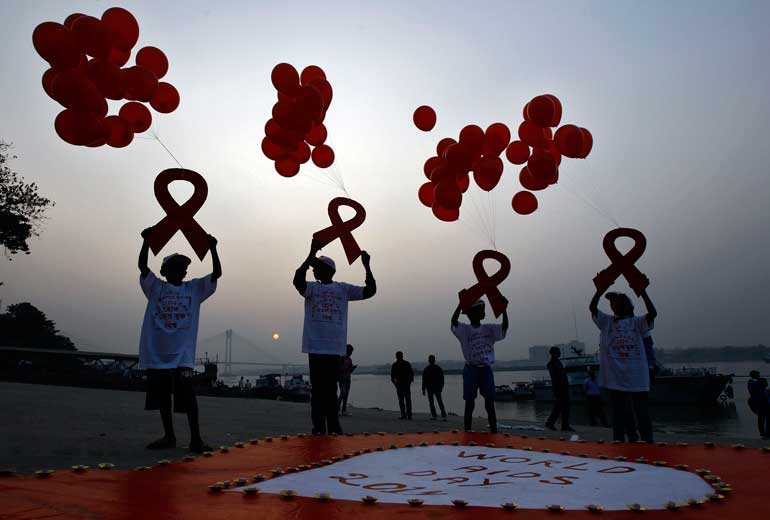
A nurse handing out a red ribbon for World AIDS Day 2014 at Emilio Ribas Hospital in Sao Paulo, Brazil
By Travis Pereira
The main theme championed for the 26th annual World AIDS day is getting to zero: Zero new HIV infections, zero AIDS related deaths and zero discrimination.
The battle against HIV/AIDS is in it’s fourth decade and the Joint United Nations program on HIV and AIDS (UNAIDS) has a goal for global eradication of the disease by 2030, and eliminating misinformation concerning the disease is at the frontier of the action plan.
“We have bent the trajectory of the AIDS epidemic. Now we have five years to break the epidemic or we risk the epidemic springing back even stronger.”
–Michel Sidibé, UNAIDS Executive Director
The campaign dubbed Fast-Track: ending the AIDS epidemic by 2030 has a five year plan to make significant leaps in the fight against HIV/AIDS by 2020.
The main target of the Fast-Track strategy is the 90-90-90 goal. By 2020, UNAIDS is aiming for:
- 90 per cent of people living with HIV to know their HIV status
- 90 per cent of people who know their HIV positive status to be on treatment
- 90 per cent of people on treatment to have suppressed viral loads (lowered amount of the virus)
Below are a few infographics representing the 2020 targets of the Fast-Track strategy. UNAIDS said the inspiration for the targets is grounded in the human rights principle of leaving no one behind.
Although the Fast-Track approach has a short-term goal of five years, UNAIDS said accomplishing these goals can lead to avoiding nearly 28 million new cases of HIV infections and 21 million AIDS-related deaths by 2030, the planned year for complete elimination of HIV/AIDS.
UNAIDS has described HIV/AIDS as the most serious epidemic in “living memory.” In order to accomplish the 2030 goal, the organization said “countries will need to use the powerful tools available, hold one another accountable for results and make sure that no one is left behind.”
In the World AIDS Day 2014 message UNAIDS executive director Michel Sidibé takes the opportunity to remind the world that a consensus formed on misinformation can be as difficult to fight as the disease itself.
The point of discrimination and stigma is an issue of paramount importance for UNAIDS.
Sidibé compares the the lack of widespread education in the beginning of the AIDS epidemic to the recent Ebola outbreak in West Africa. His message is that a lack of information leads to a lack of hope.
http://www.youtube.com/watch?v=5CQITijgILo
“If we invest just $3 (US) a day for each person living with HIV for the next five years we would break the epidemic for good.”
–Michel Sidibé, UNAIDS Executive Director
Canada is one the upper-income countries from which the UNAIDS requires meaningful investments in order to end the epidemic by 2030.
Although the domestic fight against HIV/AIDS still requires significant resources it does have the useful element of preventative measures.
Pre-exposure prophylaxis (PrEP) is such a measure and it involves the use of HIV drugs before someone is exposed to the virus.
PrEP drugs come in various forms and can require different forms of administration, and one example is Truvada which is often heralded as the first “HIV prevention pill”. The idea behind Truvada is that if individuals who don’t have HIV take the pill daily their risk of contracting the virus, if exposed, are significantly reduced.
Since PrEP is viewed as an effective tool of prevention for HIV negative people who engage in unprotected sex (among other high risk activities), critics are concerned Truvada can further discourage the use of condoms.
Despite being available in the U.S., Health Canada has yet to approve the drug. Although Truvada hasn’t been give the green light, it can be made available as an “off-label” prescription from healthcare professionals willing to prescribe it.
Despite these resources the infographic below displays some alarming statistics about HIV in Canada.

